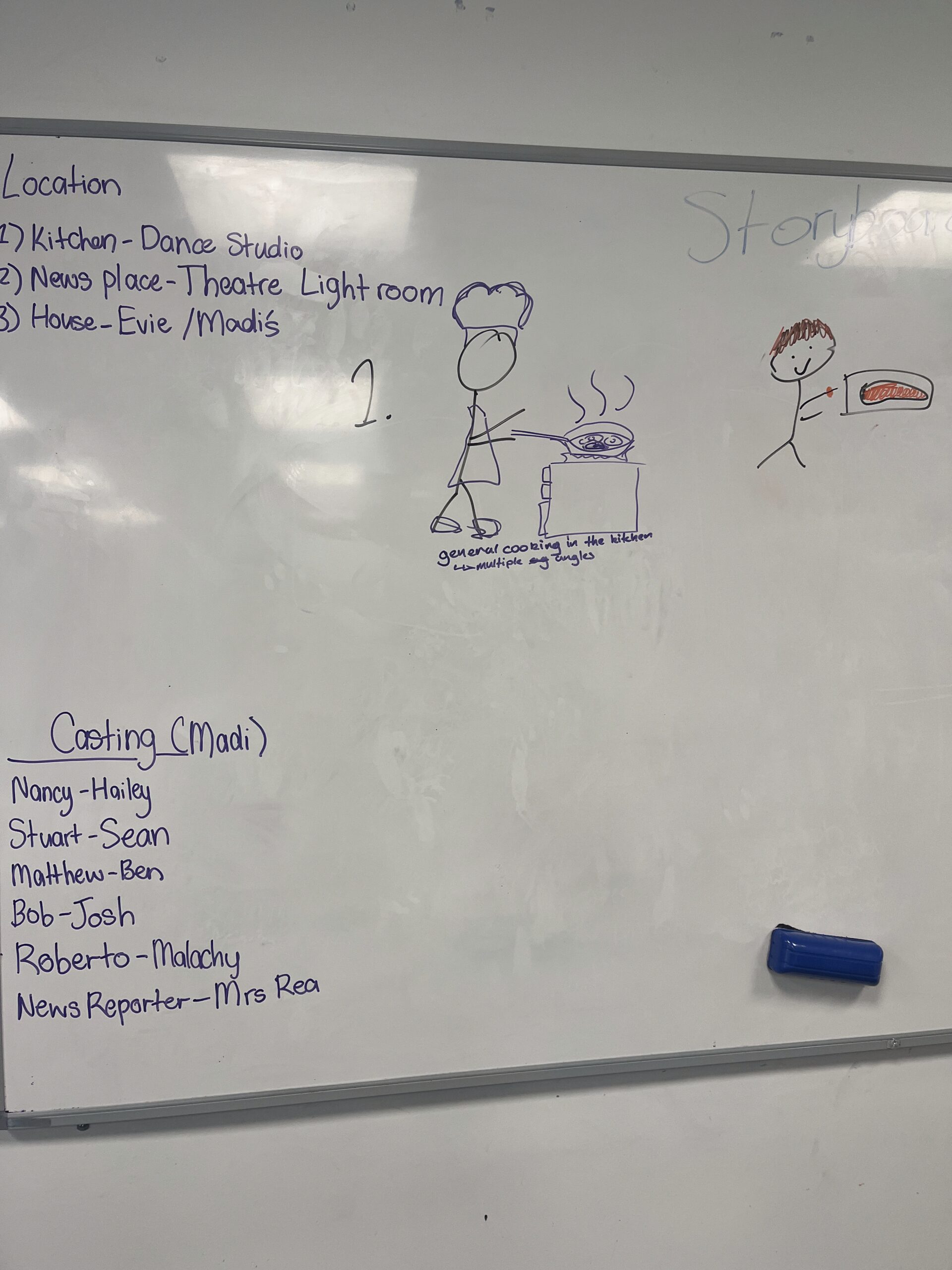
Planning for Production – Idea generation and brainstorming
This week, our class was divided into coursework groups, and we commenced the initial stages of planning for our film opening. As a group, we have begun exploring a range of possible themes, narratives, and stylistic approaches. At present, we are developing a concept within the thriller genre, focusing on a narrative involving a mysterious chef who murders a colleague and serves the victim to unsuspecting guests awaiting their meals.
The brainstorming phase allowed us to identify our preferred genre with relative ease, due to the numerous narrative possibilities that the thriller genre affords. This clarity proved advantageous in guiding our early discussions and establishing a creative direction. However, we also encountered challenges in maintaining a coherent and engaging storyline. Ensuring logical progression and narrative fluidity proved difficult at times, as any inconsistencies or disruptions in the plot risked undermining the audience’s comprehension and overall engagement—both of which are critical to the success of our project.
Our progress was also affected by the temporary absence of one group member due to illness. Their absence during the planning and brainstorming stages posed an initial setback. Nevertheless, we were able to effectively communicate our ideas upon their return, and they responded positively to the direction and concept we had developed as a team.
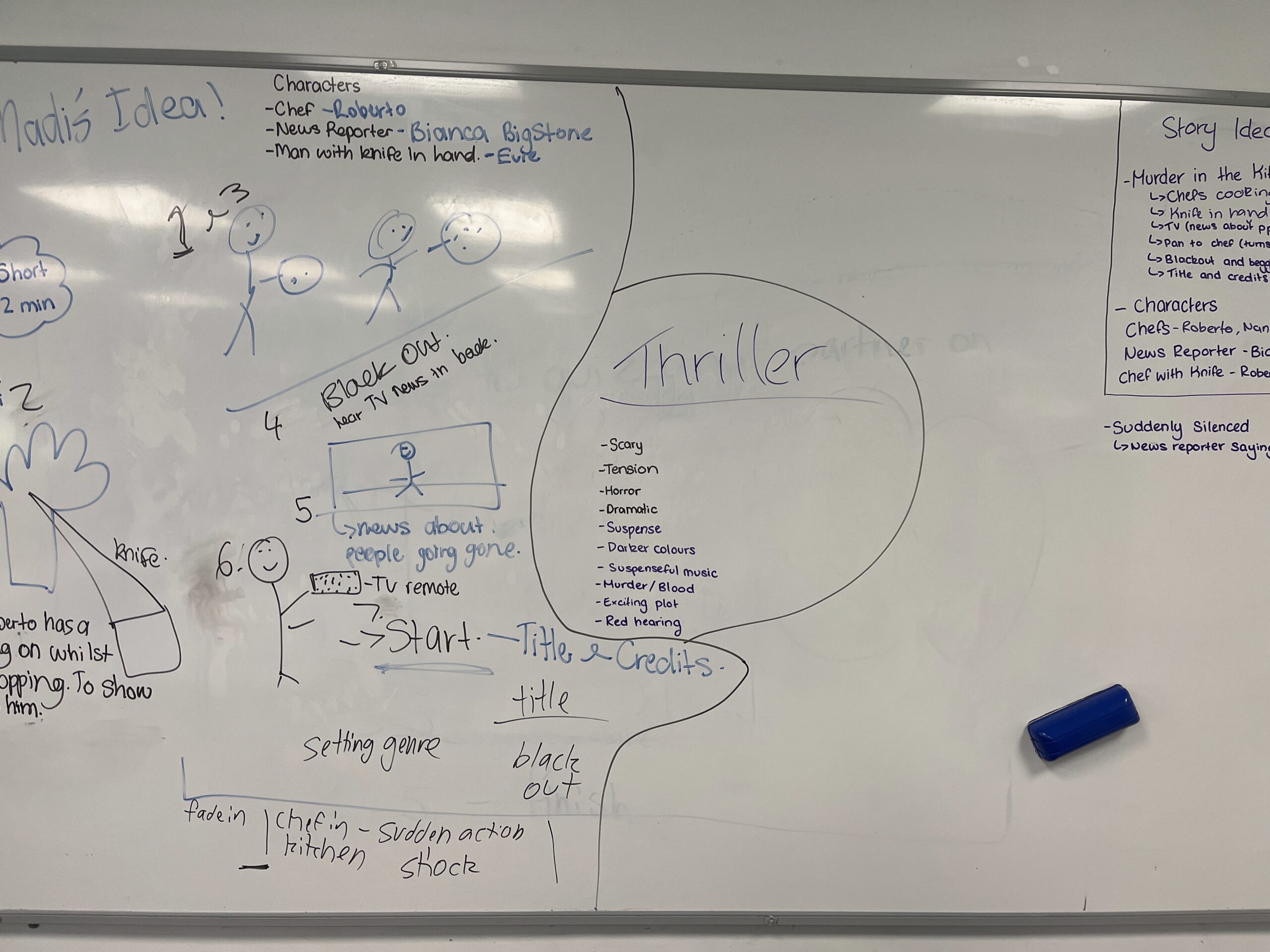
Planning for Production – Mood Board
One of my group members, Evie, was assigned the task of creating the mood board based on the tone and atmosphere I conveyed through the storyboard and our group brainstorming sessions following the development of our initial concept. The dominant colour used in the mood board is red, which symbolises danger, potential threats, and most prominently, blood. This choice of colour is instrumental in establishing a tense and unsettling atmosphere, which aligns with the themes of our thriller narrative.
The mood board also features imagery of knives, which reinforces the violent and graphic scene in which Roberto, our main character, stabs an employee in the hand. This act becomes a pivotal moment in the narrative, ultimately leading to the horrific realisation that the victim is subsequently used as food for the unsuspecting guests. The identity of the assailant is confirmed through the presence of a distinctive ring worn by Roberto—a recurring visual motif used throughout the film to signify his character.
Evie successfully curated a range of images that encapsulate the themes of mystery and unease, effectively supporting the tone of our concept. Her work on the mood board contributes significantly to our visual planning and reinforces the psychological tension that underpins the storyline.
Planning for Production – roles and responsibilities.
TToday in class, our group met to discuss and assign key roles and responsibilities as we prepare to produce our film opening. It was agreed that I would take on the roles of storyboard creator, casting director, location scout, costume designer, and lead on the storyline and initial brainstorming. These responsibilities were allocated to me as I possess strong persuasive communication skills and prior experience in recruiting individuals for various creative projects. This has already proven beneficial in identifying and encouraging potential actors to participate in our film. Additionally, I have a background in developing and expanding on small ideas, transforming them into fully realised concepts suitable for visual storytelling.
My first step towards fulfilling these responsibilities is to begin drafting the storyboard based on our current plot outline and visual tone. I will also compile a list of potential filming locations and begin coordinating with peers who have expressed interest in acting, ensuring they understand their roles and availability.
To be successful in these roles, I will need to demonstrate effective time management, clear communication with my team, and a strong creative vision. Additionally, I must remain adaptable to feedback and willing to collaborate closely with group members to ensure our project remains cohesive and aligned with our intended genre and narrative tone.
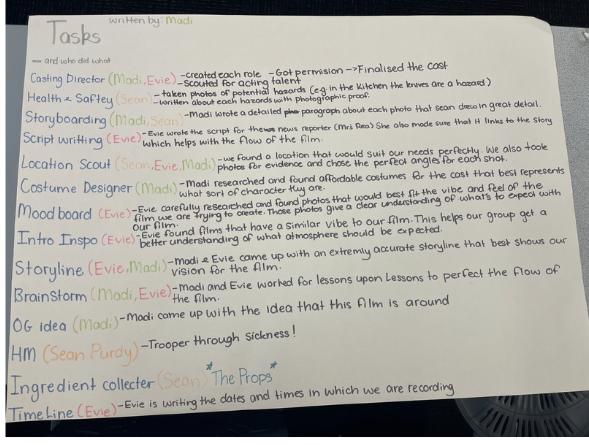
Production Process – Storyboard
Here is a summary of our group’s production preparation to date. One of the highlights of the project so far has been scouting potential filming locations that align with our narrative and visual concepts. Another enjoyable and rewarding aspect has been the creation of the storyboard. This process was particularly engaging as it allowed us to experiment with how to structure the film in a way that ensures a logical and effective narrative flow.
However, we have also encountered several challenges. One group member was absent due to illness for an entire week, which temporarily disrupted progress. Additionally, scheduling filming sessions has proven difficult, as we have had to frequently adjust dates to accommodate the availability of our cast—particularly with upcoming exams, which has added pressure and limited availability for everyone involved.
The storyboard was a collaborative effort between Sean and me. Sean was responsible for the illustrations, while I wrote accompanying detailed paragraphs to describe the action in each scene. Evie was in charge of writing the script. She worked carefully to ensure the dialogue was concise and efficient so that it would fit within our time constraints and allow room for other scenes to be filmed.
I also took responsibility for designing and organising the costumes. I ensured the costume choices were both appropriate for our characters and reflective of our intended tone, while also being mindful of budget limitations. Finally, Sean, Evie, and I collectively scouted for suitable filming locations. After we shortlisted several options, Sean took photographs and identified any potential hazards at each site to ensure we could address health and safety considerations during production.
Our storyboard, with images drawn by Sean and the written done by myself
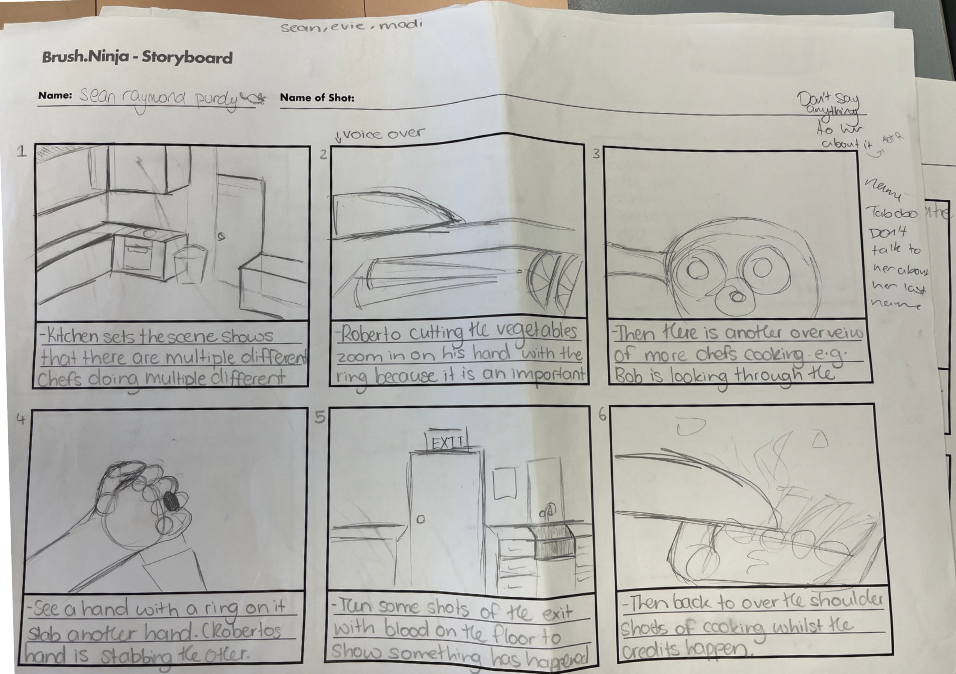
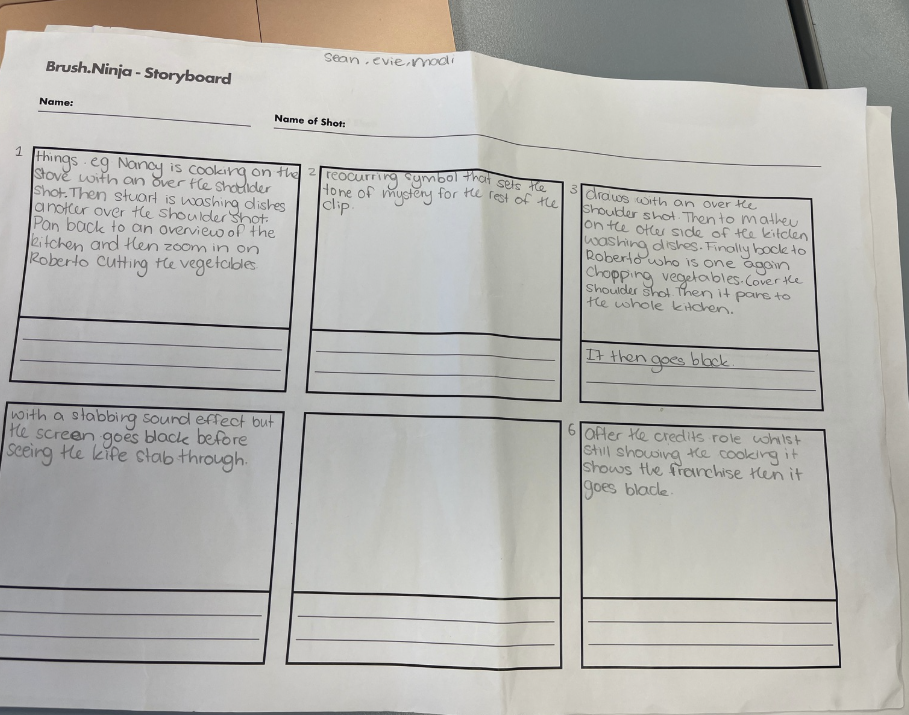
Production Process
As we get closer and closer to our filming week, our group is focusing on the completion of our storyboard and mood board, which was mainly done by Sean and I because Sean would draw the images and i would write a short description about them, which are helping us finalise the visual style and structure of our short film. Our film is about a head chef who secretly murders people and serves them to customers in his restaurant. To reflect the eerie and suspenseful tone, we used a lot of dark colour schemes, tight camera angles, and inspiration from the opening scenes of “Burnt” and “The Menu”. Both our mood board and storyboard include ideas like close-up shots of chopping vegetables, slow build ups of tension, and carefully selected lighting to create a disturbing contrast between the calmness of the kitchen and the horror that follows.
We decided that our first filming session would take place on Wednesday of Week Eight in Term Two as that was the only . On that day, we focused on shooting the kitchen scenes, which were some of the most detailed and important parts of the film. We used a tripod, ring light, and different kitchen tools to make the shots look clean and cinematic, just like the scenes we analysed from Burnt. Since then, we have now finished filming all the scenes, including the news report scene and the final abandoned kitchen shot. These final shots helped bring the story together and gave the ending a haunting, empty feeling. We are now close to finishing editing, and have been adding sound effects, background music, and colour grading to match the mood we planned out earlier. We’ve also been cutting and rearranging clips to improve the pace and build suspense in the right moments.
As an individual, my next step is to make sure my blog is completed to a high standard. I will include written reflections, screenshots of our editing process, inspiration from other films, and explain how our film developed over time. I also want to show how we responded to challenges and made creative choices throughout the process. So far, our biggest challenge has been managing timing, as it was difficult to find days when everyone in the group was free to film. Despite this, we stayed organised and communicated well, which helped us meet our deadlines. Overall, this process has been really valuable in helping me understand how to plan, shoot, and reflect on a short film in a professional way.
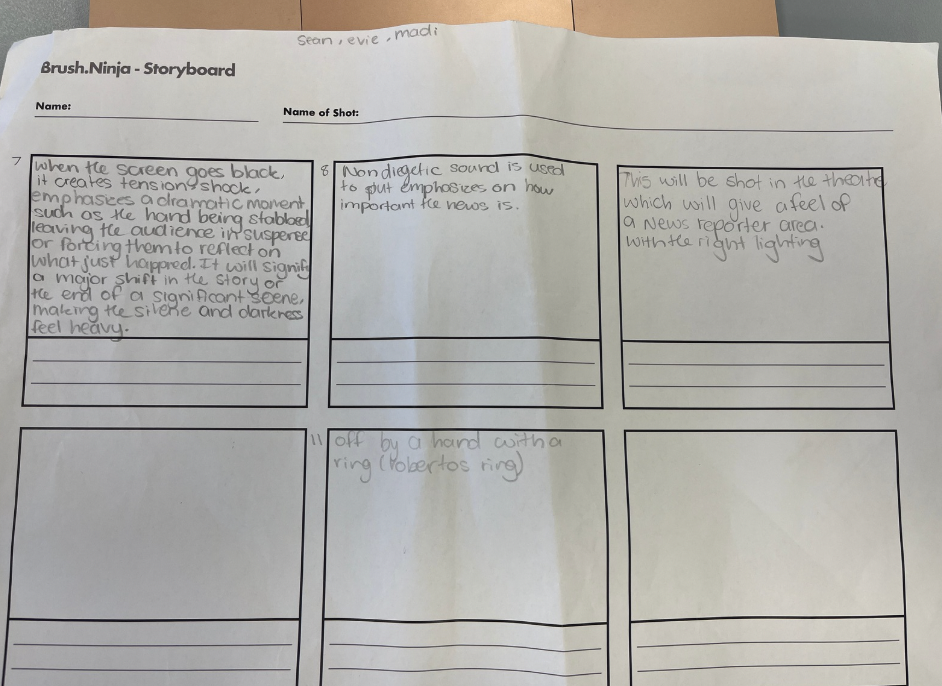
Our storyboard, with images drawn by Sean and the written done by myself
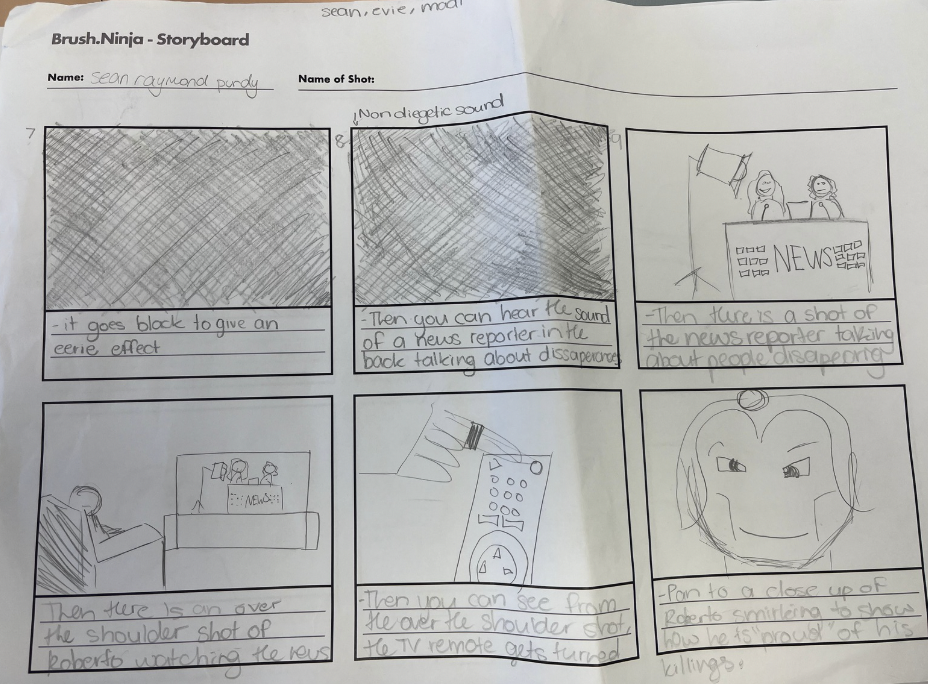
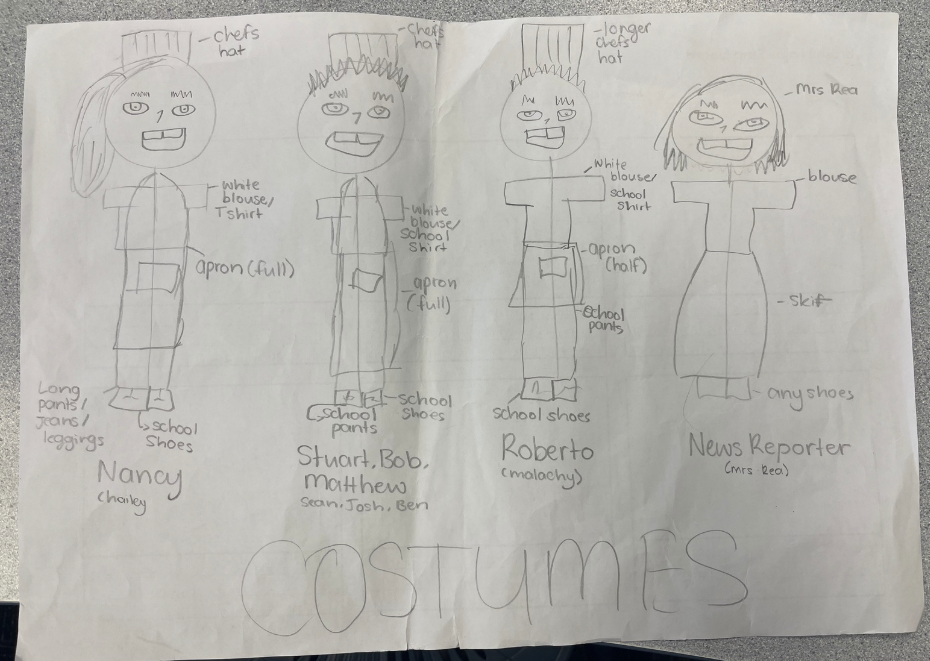
Filming
During our filming process, our group, which consisted of me, Evie, and Sean worked together to create a short film that blended dark humour with suspense. We began filming at school in the kitchen which we booked out in the dance studio, which provided a commercial looking environment perfect for our opening scene. This scene involved several chefs preparing food one of which was the main chef and this could be seen through the apron which was only a half apron, which i decided as the costume designer would help show the audience that there was a difference between him and then rest of the chefs. This was also shown with lots of close up shots of chopping to create a fast paced, dramatic effect. The climax of this scene was when the main chef stabbed another chef’s hand. We left it to the audience to assume that the hand would be served as part of the meal, helping to establish the disturbing tone of our film which we had taken inspiration for from other film openings one being “The Menu”.
Earlier that week, we filmed a fake news report on the school field during lunch using one of our teachers as the news presenter. This was done in advance so we could edit it and use it in the next scene where the head chef was in the kitchen and living room (at my house) watching the news. Once the news segment was ready, we filmed at my house. We connected the edited video to the TV so that, in the scene, the head chef could watch the news report. The report revealed that 26 people had been reported missing an obvious connection to the chef’s earlier actions in the kitchen where he stabbed another chefs hand. This added to the storyline and helped to explain the film’s dark twist.
After we finished editing, we felt that something was missing. The suspense had dropped off slightly since the audeince could see who had killed those “missing” people, and we wanted to bring it back. So, during one of our study periods, Evie and I returned to the school kitchen and filmed a final scene. We trashed the kitchen to make it look abandoned and eerie. I lay in the background with my legs hanging out to make it look like there was a dead body on the floor. This added a strong element of surprise and suspense back into the story, which was really effective in finishing the film on a chilling note.
We were successful in getting a lot done in the time we had, which I think was a major achievement and helped us to create enough time to get some helpful feedback. One challenge we faced was trying to find a time when everyone, especially the background chefs, were available to film as everyone was either working or doing a sport in the afternoon. Since there were quite a few people involved in some scenes, coordinating everyone’s schedule was tricky. Luckily, we didn’t need to re-shoot anything. The only extra scene we filmed was the final kitchen one, which we hadn’t originally planned but later realised was necessary later on.
In post production, we plan to dim the lighting in our footage during editing to make the scenes look more intense and scary especially since we filmed during the day so we couldn’t get at eerie and suspenseful atmosphere. We’ll also add non-diegetic sound, like eerie background music, to increase the tension and better match the tone of the story. Through this whole process, I’ve learnt how important it is to have a solid plan from the beginning. It helps avoid unexpected issues and ensures that the storyline stays strong.
Specifically, my role during filming was organising all of the costumes for our characters which I though I did well especially to capture the different rankings of the chefs, which helped with consistency and realism, and I also hosted the filming session at my house. Overall, I’m proud of what our group achieved and excited to see the final edit come together.



Rough Cuts Review
This week in class, we had the opportunity to conduct some market research by presenting key scenes from our short film to the rest of our class. Evie showed rough edits of different scenes and I explained the plot, theme, and characters to give our audience (which was our AS media class) a clear idea of what we were trying to achieve with the plot of our short film. As a group, we were mainly looking for feedback on how easy it was to follow the storyline. To gather this information, we created a Microsoft Form that included both multiple choice and open-ended questions.
From the feedback our group had received, most of the class thought our short film had a strong concept and they really liked the overall tone which was good to hear as it took us quite a few weeks to make sure that the overall idea for the film would flow correctly. Our teacher commented after we presented, “The use of colour and lighting created a creepy but really cool atmosphere that fits the theme perfectly.” Another said, “I liked the twist with the chef—it was unexpected and clever.” However, a few students mentioned that the storyline became confusing in some places. One person wrote, “I got a bit lost around the news scene and wasn’t sure who was dead or alive,” and another said, “Maybe clearer transitions between scenes would help the viewer understand what’s going on.” This feedback helped us realise that while our concept is strong, we need to work on how the story is communicated which was good to know now so that we could fix it promptly.
Our teacher also gave us detailed feedback. They noted that we had considered colour symbolism and used mise-en-scène and lighting well for our genre. They said the use of the knife as a motif was effective and that camera techniques were chosen appropriately for the impact we wanted. They also commented positively on our teamwork and task delegation we also thought that our delegation was good as it meant that we could effiecenitly sort out any tasks that were needed to be done. However, they suggested that our storyboard images (which we found on Pintrest) lacked detail and that we could be more creative with our narrative to better match the genre and ensure a clearer link between the scene and our prompt. This will help ensure the audience receives our preferred reading of the story.
Based on this feedback, our next steps are to focus on making the storyline clearer so the audience can follow it more easily. This includes possibly reordering some scenes, adding clearer visual or audio transitions, and making the relationship between characters and events more obvious this will help the audience understand who the main chef is as well since there were four other chefs in the kitchen. We also plan to update our storyboard with more detailed images and include editing notes to improve the overall impact.
We will include evidence of our audience feedback by attaching screenshots from our Microsoft Form, quotes from viewers. We also plan to include clips of the original footage that received criticism, along with the updated versions, to clearly show the improvements we’ve made in response to the feedback.
Edits
Based on the feedback we got from our class and our own reflections, we made a few important changes to our short film. One of the main things people said was that the storyline was a bit confusing, especially between the kitchen stabbing scene and the news report. So, we changed the order of a few scenes to make it flow better and added a short voiceover to help explain the connection between the head chef and the missing people. We also added a moment where the chef smirks while watching the news to hint that he’s behind it.
Another thing people mentioned was that the suspense dropped off halfway through. To fix that, we filmed an extra scene back in the kitchen during our study period. We trashed the kitchen to make it look abandoned, and I lay on the ground with my legs sticking out to make it look like a body was left behind. This helped bring back the creepy vibe and gave the film a more dramatic ending.
We also made the lighting darker in editing and added some scary background music to match the tone we were going for. Our teacher gave us feedback about our storyboard being too simple, so we added more notes and details to explain our editing ideas.
Overall, we made these changes to help the audience follow the story better and keep them hooked from start to finish. I also helped by organising the costumes and hosting the filming at my house. These changes really helped bring our whole idea together.
Below are some links to videos of our edits before the final one:
